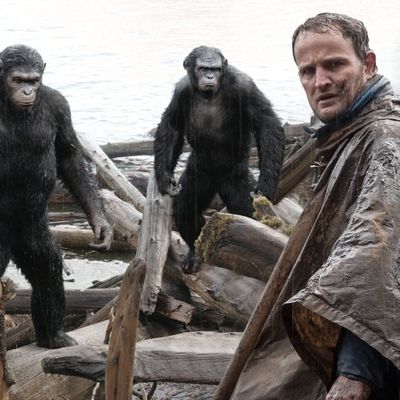
The latest Apes picture, Dawn of the Planet of the Apes, is an excellent interspecies bromance between an ape and a man who’d like to live in peace but are surrounded by warmongering assholes.
The apes — who have begun to pick up English — are basically stand-ins for Injuns, living in the forests of Marin County, hunting and gathering and minding their own beeswax. The few hundred humans — genetically immune survivors of a simian flu that has wiped out most of their kind — have gathered in a San Francisco compound, where they’re now out of the power they need to “rebuild and reclaim the world [they] lost.” The apes, you see, reside where said power is, beside a dam — hence the conflict.
One nasty human, played by Gary Oldman (nice casting!), has a thing against apes and is especially keen on wiping them out. One nasty ape, Koba (Toby Kebbel plus CGI), has a similar thing against humans, which makes sense since once upon a time they did hideous experiments on him. The sane ones are Caesar, the leader and most verbal of the apes, played by Andy Serkis plus CGI; and a human, Malcolm, played by Jason Clarke, as convincing a good guy as he was torturing Iraqis in Zero Dark Thirty. It takes a while for Caesar and Malcolm to trust each other, and by the time they do, the odds are long that they’ll keep a full-scale war from breaking out.
The new film, directed by Matt Reeves (Let Me In), is a follow up to Rupert Wyatt’s Rise of the Planet of the Apes, and the question hangs whether the new series is building to the latest incarnation of Charlton Heston landing on a monkey planet or something more upbeat.* I should say that Dawn, despite the loss of billions of humans, is among the sunniest in a series that in one installment featured the incineration of the entire planet. The nihilist vision has been there from the start. This one at least has a humanist (or perhaps, out of deference to the peaceable apes, we should say pacifist) thrust and offers some hope, however fleeting, that monkey and man can reach across the evolutionary chasm.
It is certainly thrilling to see how Reeves and his CGI wizards bring their hordes of apes to life. Honestly, if I didn’t know they were computerized, I’d have thought they’d brought off an evolutionary miracle. Serkis in particular affects a good simian stance — arms slightly raised at his sides, teeth bared, flat nostrils in the air, and barking his lines à la Toshiro Mifune.
Caesar is sad that some humans are gone — he misses James Franco and John Lithgow, who, in Rise, romped with him and taught him chess and tried to protect him from probes being thrust into his fundament. But he’s properly on guard, as an emperor must be. The scene in which Malcolm is led — accompanied by Michael Giacchino’s grand, scary music, which pays suitable homage to Jerry Goldsmith — past animal carcasses displayed like talismans to what is Caesar’s treetop throne room is magnificent. Dawn is a triumph of design and animation.
As usual with these big-budget behemoths, there are five climaxes, and not much to do for the likes of Keri Russell (as Clarke’s squeeze) and the delectable Judy Greer, who’s apparently somewhere underneath one of the apes. One of the best scenes is when Koba does a hilarious ape–Stepin Fetchit act for two drunken human artillery nuts before blowing them away, but there aren’t many laughs beyond that. Even given the spate of post-apocalyptic and dystopian films that rule the multiplexes, this is the bleakest “franchise” in human history, and I’m curious if there will be any balm whatsoever in the next close encounter of the furred kind.
* This review has been corrected to properly credit Rupert Wyatt as the director of Rise of the Planet of the Apes.


